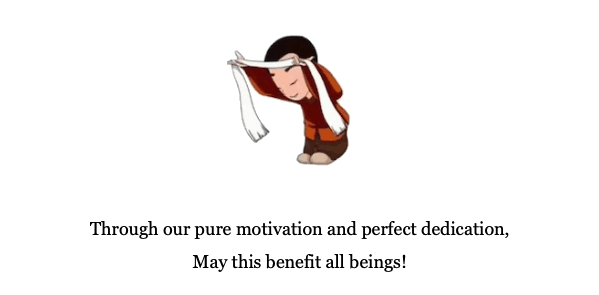03-L'éthique bouddhiste dans le Hinayana
Buddhist Ethics of Personal Liberation
The focus of the ethics of personal liberation is to control impulses that lead body and speech to undertake negative actions. Because such actions are always linked to limiting emotional patterns, Individualists, in addition to observing ethics, must train in the discriminative awareness that realises selflessness to attain perfect peace, the state of cessation of such patterns. Furthermore, for that meditation to be stable, mental concentration also must be cultivated. Thus, personal liberation ethics are essentially identical with training in morality, meditation, and wisdom. Although the aim of the monk’s vows and other personal liberation vows appears to be restraint from unwholesome physical behaviour, it would be misleading to view those vows reductively, because their implicit aim is to overcome limiting mental patterns.
The foundation of these ethics lies in the precepts relating to taking refuge and the four “root,” or crucial, precepts that prohibit murder, theft, lying, and adultery. Refuge relates to the Buddha, the Dharma, and the Sangha: the first is understood as the Teacher, the second as the teachings, and the third as the community (here the monastic one in particular). Originally, taking refuge was primarily an expression of faith that distinguished a follower of the Buddha from practitioners of other religions. Refuge marked the beginning of an earnest undertaking of the Buddhist path. In higher forms of Buddhist view and methods of implementation, refuge takes on deeper layers of meaning, and in the ultimate sense means taking refuge in “the buddha within,” the realization of the natural and unmodified intrinsic awareness lying within oneself.
The four root precepts prohibit the four actions that would undoubtedly cause suffering for others and also compromise the tranquility of one’s mind, thereby destroying one’s chance to develop meditation and gain the discriminative awareness needed to uproot cyclic existence.
When the Buddhist community was first being formed, taking refuge in front of the Buddha was all that was needed for one to be accepted as a monk. Gradually, because of the misbehavior of monks and for other reasons, rules were instituted, for the most part limited to a particular temporal and social context. Many were intended not only for the welfare of the monks themselves, but also for the community’s internal harmony and external social respectability.
Rules gained more importance; to be a monk became a matter of maintaining specific rules and regulations rather than a matter of freely heading into a spiritual life. Eventually, to enter the Buddhist community, the aspirant needed to assume vows, and vows came to represent a commitment to abide by the entire body of rules. Such vows were not simple promises. Instead, they were “generated” in the candidate through a series of conditions and requisites, such as the abbot, and their primary requirement was an attitude of disengagement from cyclic life.
As the vow developed into an “entity,” the identification of its nature became an important matter, which explains the various assertions Kongtrul presents, based on detailed analyses, on the nature of the vow. The conclusions would have little relevance to the keeping of the rules themselves but would definitely be relevant to determining at what point a vow is lost.
Personal liberation vows are basically of two kinds: those that prohibit actions such as killing and lying, which are considered unwholesome for anyone who commits them; and those that prohibit actions such as eating in the evening, which are improper only for monks and nuns. The first kind involves a concept of “natural evil,” or “absolute morality,” which is probably influenced by the realist philosophical view held by the Analysts, to whom the tradition of personal liberation is undoubtedly connected. That also explains, to some extent, why the personal liberation vow is compared to a clay pot; once broken, it cannot be repaired.
The Ethics of the Mind of Awakening (Mahayana)
The focus of the commitments of the mind of awakening is the training to be followed on the bodhisattva path. As these commitments are centred on the awakening mind itself, its causes, nature, varieties (the aspiring and venturing, the relative and ultimate), and so forth are explained in detail before the training itself is described.
The actual cultivation of the awakening mind, attended by specific points of training, is presented from the perspective of the lineage of the profound view, which was inspired by Manjushri and transmitted to Nagarjuna, Shantideva, and others, and the magnificent deeds lineage, which was inspired by Maitreya and transmitted to Asanga, Chandragomin, Atisha, and others.
These two systems are basically the same, and certain aspects of training are common to both. The common training includes the three forms of ethics for the bodhisattva, which are to shun non-virtue, acquire wholesome qualities, and work for the benefit of others, and the implementation of the six perfections: generosity, ethics, patience, effort, meditation, and wisdom.
Nagarjuna’s system allows anyone who is willing and sufficiently intelligent to take the commitments of the aspiring and venturing awakening minds simultaneously, either in front of a master or alone in the imagined presence of buddhas and bodhisattvas. As long as one preserves the mind that aspires to awaken, the commitments are not lost. A damaged commitment can be restored in a dream through supplication to the bodhisattva Akashagarbha; the bright trainee re- stores damaged commitments through the understanding of the unborn nature of things. The points of training are followed according to one’s ability, and the commitments are taken for a period as long as one estimates one can safeguard them.
In Asanga’s system, only a person who holds one of the seven sets of personal liberation vows is entitled to assume the awakening-mind commitments, and such a person does so gradually (in different ceremonies), first accepting those of aspiration and then, once he or she has gained proficiency, those of venturing. It is recommended that one assumes the commitments in the presence of a qualified master. If a major infraction has been committed with great emotional involvement, the commitment is deemed to be lost and must be taken anew. (Here Kongtrul adds an enigmatic note from the great Dzogchen master Longchenpa, which says that the commitment, once it has deteriorated, cannot be retaken more than three times.) The infraction should be confessed in the presence of vow holders. According to this lineage, the trainee must safeguard all of the points of training from the very beginning and must promise to keep the commitments until he or she attains enlightenment, not just for a selected period of time.
Nagarjuna’s system seems more lenient and less influenced by monasticism than that of Asanga, whose points of training are more complex. Presumably, differences in the two traditions stem from their different emphases: the profound view lineage stresses the knowledge aspect of the path; the lineage of magnificent deeds, the con- duct, or method, aspect.
Historically and psychologically, the bodhisattva’s path is halfway between the paths of renunciation and transformation. The peacock whose feathers grow more colorful as a result of eating poison symbolises the bodhisattva, who remains unpolluted and grows more radiant as his involvement in the world deepens. Accordingly, the Cluster of Jewels Scripture says:
Just as the paddy and cane-sugar fields are nurtured by the ordure of the village, likewise, the sprout of the awakening mind is nurtured by the ordure of the emotions of a bodhisattva.
Such images clearly show that the Universal Way transcends the Individual Way’s form of renunciation, which regards “objects of desire...as poisonous leaves.” This transcendence of strict renunciation holds the seed of the principle of transformation, which is developed to its fullest extent in tantra.
The Universal Way prescribes a set of personal liberation vows that are not radically different from those of the Individualists. Because Universalists are distinguished for their noble intention of seeking enlightenment in order to serve all living beings, however, there is a fundamental difference in principle between their form of observance and that of the Individualists. Moreover, since the philosophical trends underlying the Universal Way stress the selflessness of phenomena and, in particular, the Centrists speak of the non-reality of all appearances, how could morality, or ethics, in the bodhisattva path be asserted as absolute rather than as a variable factor dependent on conditions? The Universal Way therefore exhibits a flexible approach to the personal liberation vows and goes so far as to say that a bodhisattva may engage in the seven unwholesome actions of body and speech if motivated by love and compassion.
As Shantideva says:
The Compassionate One, in his broad vision, gave permission even for what is prohibited.
Owing to its focus on mental disposition, the ethics of the awakening mind, if damaged, can be renewed or repaired by the bodhisattva, just as a golden vessel can be repaired by a skilled goldsmith.





